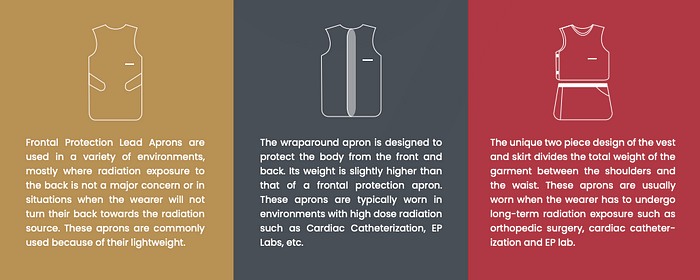
Introduction:
When it comes to selecting a lead apron, several crucial factors need to be taken into account to ensure optimal protection and comfort. From the level of radiation protection to size and fit, weight, core and outer materials, cleaning and maintenance requirements, and cost, each aspect plays a vital role in making the right choice. In this comprehensive guide, we will explore these factors in detail, helping you make an informed decision when selecting a lead apron that suits your specific needs.
1. Protection Level:
Consider the type of radiation exposure expected in your workplace and choose the appropriate lead equivalency for your apron. Factors such as radiation type, energy level, and duration of exposure should guide your decision. Lead aprons are available in different lead equivalencies, ranging from 0.25 mm to 0.5 mm, catering to varying levels of radiation exposure.
2. Size and Fit:
Ensure a proper fit to guarantee adequate protection. Take into account the wearer’s height, weight, and body shape when selecting a lead apron. An ill-fitting apron can leave vulnerable areas exposed and reduce its effectiveness. Comfort and mobility are equally important, as medical professionals often wear aprons for extended periods. Look for an apron that is comfortable, balanced, and allows for ease of movement.

3. Weight:
Heavy lead aprons can lead to back and shoulder pain, potentially causing musculoskeletal injuries over time. Choose a lightweight and well-balanced apron to reduce the risk of strain and injury. Additionally, consider the distribution of weight to ensure maximum comfort and mobility during work activities.

4. Core Material:
The core material used in a lead apron impacts its weight, cost, durability, and effectiveness. Common core materials include lead rubber, lead vinyl, lite lead, and lead-free options. Each material offers the same level of radiation protection but differs in weight and cost. Consider your specific requirements and budget when making a choice.

5. Outer Material:
The outer material of a lead apron is also significant. Popular choices include PU coated fabric and ripstop fabric. PU coated fabric offers antimicrobial and anti-odour properties, making it ideal for medical settings where hygiene is crucial. Ripstop fabric, on the other hand, is durable and suitable for extreme conditions or outdoor settings.

6. Cleaning and Maintenance:
Follow the manufacturer’s instructions for cleaning and maintenance to ensure the longevity and effectiveness of your lead apron. Different materials may require specific care and handling. Regularly inspect the apron for wear and tear, and address any issues promptly to maintain its functionality.
7. Cost:
While cost is a consideration, prioritize quality and effectiveness over price alone. Investing in a reliable lead apron ensures long-term protection and durability. Consider the overall value and benefits of the apron when making your decision.
Conclusion:
Choosing the right lead apron involves considering the protection level, size and fit, weight, core and outer materials, cleaning and maintenance requirements, and cost. By carefully evaluating these factors, you can select a lead apron that provides optimal radiation protection, comfort, and mobility. For high-quality lead aprons, you can explore reputable manufacturers like IndoSurgicals Private Limited. Remember to visit their website www.indosurgicals.com for detailed information and consult their catalog for further reference.
(Note: The mentioned manufacturer, IndoSurgicals Private Limited, and its offerings are used solely for illustrative purposes in this blog post.)

Comments
Post a Comment